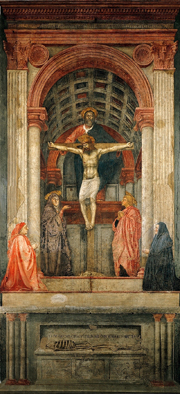| Notes: | "Several diverse interpretations of the fresco have been proposed. Most scholars have seen it as a traditional kind of image, intended for personal devotions and commemorations of the dead, although explanations of how the painting reflects these functions differ in their details.[4] The iconography of the Trinity, flanked by Mary and John or including donors, is not uncommon in Italian art of the late 14th and early 15th centuries, and the association of the Trinity with a tomb also has precedents. No precedent for the exact iconography of Masaccio's fresco, combining all these elements, has been discovered, however. The figures of the two patrons have most often been identified as members of the Lenzi family or, more recently, a member of the Berti family of the Santa Maria Novella quarter of Florence.[5] They serve as models of religious devotion for viewers but, because they are located closer to the sacred figures than the viewers are, they also lay claim to special status. The tomb consists of a sarcophagus on which lies a skeleton. "Carved" in the wall above the skeleton is an inscription: "IO FU[I] G[I]A QUEL CHE VOI S[I]ETE E QUEL CH['] I[O] SONO VO[I] A[N]C[OR] SARETE" (I once was what you are and what I am you also will be). This memento mori underlines that the painting was intended to serve as a lesson to the viewers. At the simplest level the imagery must have suggested to the 15th-century faithful that, since they all would die, only their faith in the Trinity and Christ's sacrifice would allow them to overcome their transitory existences.According to American art historian Mary McCarthy:The fresco, with its terrible logic, is like a proof in philosophy or mathematics, God the Father, with His unrelenting eyes, being the axiom from which everything else irrevocably flows.[6]" [from Wikipedia] |
|---|

